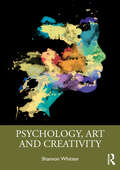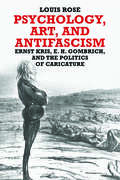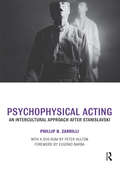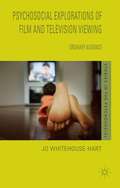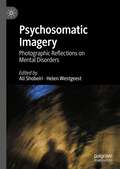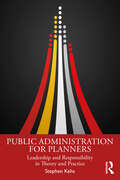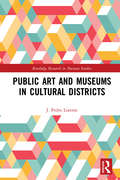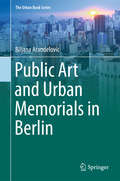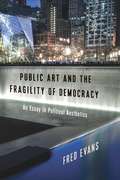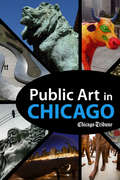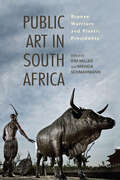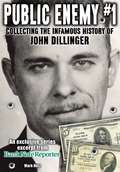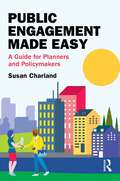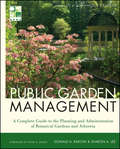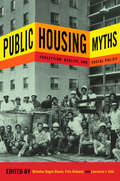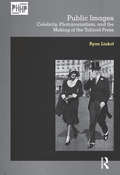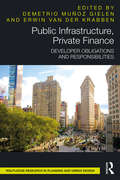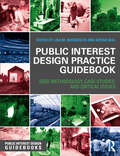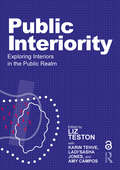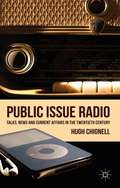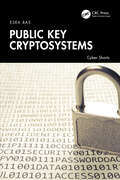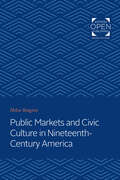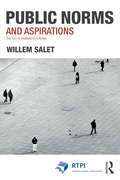- Table View
- List View
Psychology, Art and Creativity
by Shannon WhittenThis comprehensive text challenges the taken-for-granted opposition of science and art by combining the fundamental principles of psychology, art and creativity and presenting the interdependent disciplines together in one unique, clear, and accessible resource. The author, Shannon Whitten, begins with an introduction to the foundations of art and psychology, providing readers with a critical understanding and history of the key concepts in both disciplines before establishing their interdependency. Drawing on a solid evidence base, the book then presents an assortment of extensive topics, from the human perception of color to the ability of art to impact mental health. The exploration of these topics enables the reader to reflect on the phenomenal power of human creativity. The chapters include vital categories of human psychology such as emotion, perception, personality, and social psychology to show the extensive connections between these elements of experience and art. Featuring a wealth of additional resources, this illuminating text equips the reader with a sound knowledge of the vocabulary and issues in the study of empirical aesthetics through visual content and stimulating prompts for reflection. Emphasizing the link between creativity and good mental health, the book is an essential read for students of the psychology of art, creativity, art therapy, and empirical aesthetics, as well as any discipline within the humanities, arts and science. It will also be of relevance to anyone interested in understanding the psychology behind creativity and its therapeutic effects on the artist.
Psychology, Art, and Antifascism: Ernst Kris, E. H. Gombrich, and the Politics of Caricature
by Louis RoseA vivid portrait of two remarkable twentieth-century thinkers and their landmark collaboration on the use and abuse of caricature and propaganda in the modern world In 1934, Viennese art historian and psychoanalyst Ernst Kris invited his mentee E. H. Gombrich to collaborate on a project that had implications for psychology and neuroscience, and foreshadowed their contributions to the Allied war effort. Their subject: caricature and its use and abuse in propaganda. Their collaboration was a seminal early effort to integrate science, the humanities, and political awareness. In this fascinating biographical and intellectual study, Louis Rose explores the content of Kris and Gombrich's project and its legacy.
Psychophysical Acting: An Intercultural Approach after Stanislavski
by Phillip B. ZarrilliPsychophysical Acting is a direct and vital address to the demands of contemporary theatre on today’s actor. Drawing on over thirty years of intercultural experience, Phillip Zarrilli aims to equip actors with practical and conceptual tools with which to approach their work. Areas of focus include:an historical overview of a psychophysical approach to acting from Stanislavski to the presentacting as an ‘energetics’ of performance, applied to a wide range of playwrights: Samuel Beckett, Martin Crimp, Sarah Kane, Kaite O’Reilly and Ota Shogoa system of training though yoga and Asian martial arts that heightens sensory awareness, dynamic energy, and in which body and mind become onepractical application of training principles to improvisation exercises.Psychophysical Acting is accompanied by Peter Hulton’s downloadable resources featuring exercises, production documentation, interviews, and reflection.
Psychosocial Explorations of Film and Television Viewing
by Jo Whitehouse-HartMost people have, at some point in their lives, experienced powerful, often strange and disconcerting, responses to films and television programmes of which they cannot always make sense. Psychosocial Explorations of Film and Television Viewing takes as its subject the seemingly mundane and everyday activity of watching television and films in the home, arguing that the affective and emotional experiences generated for audiences make this activity in fact extraordinary. Based on a fascinating empirical study of audiences' "favourite" films and television programmes, the book unravels the biographical and emotional intensity of viewing, from a psychosocial perspective. Drawing on insights from psychoanalysis including the work of Sigmund Freud, Melanie Klein, Donald Winnicott, Wilfred Bion and Christopher Bollas, and sociological theorists such as Pierre Bourdieu, the book argues that viewing is a psychosocial activity which must consider the relationships and processes between "inner" and "outer" worlds. Important ideas from media audience research are revisited, to show that families and biographical experiences influence audience identification, interpretation and uses of television. The in-depth case studies show that whilst viewing can be pleasurable, in the conventional sense of enjoyment, it can also be anxiety-provoking and contradictory. Employing psychoanalytic methods for social and cultural research, this book is an important contribution to Media Studies, Film Studies, Cultural Studies and Psychosocial Studies.
Psychosomatic Imagery: Photographic Reflections on Mental Disorders
by Helen Westgeest Ali ShobeiriThis book explores the potential of specific photographic images for reflecting on experiences of mental disorders. Instead of looking at photographs of (people suffering from) mental disorders, this volume aspires to comprehend the complexities of such conditions through photographic lexicons, metaphors, and practices. For this book, a mental disorder is not to be seen as a dysfunction or impairment, but a state in which the sustaining balance of stable and unstable mind is unsettled, which may induce mental/bodily disturbances. The term “psychosomatic” refers to the interaction of the mind (psyche) with the body (soma); it refers to their co-dependence. By the term “Psychosomatic Imagery” this volume refers to a distinctive trope of photographic images that deal with the body-mind interaction during the states of mental disorders. This novel theoretical framework in photography theory instigates critical discussions about the experiences of mental disorders visualized as disturbed corporeal and mental perceptions of the world. While the introduction of the volume unpacks and assesses the applications of photography in mental disorder studies from theoretical and historical perspectives, the chapters focus on specific cases of Psychosomatic Imagery in contemporary photography. Those cases include, but are not limited to: PTSD, hysteria, paranoia, psychosis, bipolar disorder, and Hikikomori.
Public Administration for Planners: Leadership and Responsibility in Theory and Practice
by Stephen KehsThis book offers an introduction to public administration by a veteran practitioner, written for planners, as well as students seeking a public administration career and individuals simply wanting to learn more about responsible government. The narrative provides an overview of public administration theory and the importance of leadership in today’s contentious political environment. The book contains five parts including an introduction, parts on management, the public sector and government programs, and some impressions on why this subject is so critically important in our society today. Typical administrative responsibilities are addressed as well as issues not typically covered in books on public administration, along with observations about sound public administration. Each part also contains practical exercises, discussion questions and references to other texts and academic resources. Because public administration is fundamentally about relationships with people and communities, the book provides lessons that can be applied easily to one’s personal life and experiences. It is a timely narrative on public administration today that will be valuable reading for planners and planning students looking to better understand public administration and policy.
Public Art and Museums in Cultural Districts (Routledge Research in Museum Studies)
by J. Pedro LorenteMuseums and public art have traditionally taken significantly different approaches to customer engagement, but throughout history they have also worked together in some urban contexts, notably as landmarks of so-called cultural districts. Public Art and Museums in Cultural Districts reviews their changing interactions in many different types of cities since the Enlightenment, or even before, going back to the etymological origins of museums and monuments in classical antiquity. The type of historical enquiry presented within the volume is not intended as a total narrative, but the international study cases considered convey a global panorama of the shifting paradigms set in different periods by some cultural neighbourhoods and emulated worldwide. Blurring boundaries between art history, museology and urbanism, this critical account explores past tensions, achievements and failures, giving insightful consideration to present policies and pointing out reasonable recommendations for the future regarding public heritage. Presenting for the first time an insights into the role of collections of public art as landmarks of cultural districts, this book considers collections displayed outdoors from the double perspective of curatorial outreach and civic values. This book will fill a gap in the existing museum studies literature, hitherto mainly focused on indoor collecting and curatorial policies, but increasingly more and more attentive to their outside context. As such, the book should be of great interest to academics, researchers and students working in the fields of art, heritage, museum studies and urban history. It should also be of value to professionals working in the museum and art sectors.
Public Art and Urban Memorials in Berlin (The Urban Book Series)
by Biljana ArandelovicThis book provides insight into the significant area of public art and memorials in Berlin. Through diverse selected examples, grouped according to their basic character and significance, the most important art projects produced in the period since World War II are presented and discussed. Both as a critical theoretical work and rich photo book, this volume is a unique selection of Berlin’s diverse visual elements, contemporary and from the recent past. Some artworks are very famous and are already symbols of Berlin while others are less well known. Public Art and Urban Memorials in Berlin analyzes the connections created by public art on one hand, and urban space and architectural forms on the other.This volume considers the Berlin works of iconic artists such as Christo and Jeanne-Claude, Daniel Libeskind, Dani Karavan, Bernar Venet, Keith Haring, Christian Boltanski, Richard Serra, Peter Eisenman, Henry Moore, Claes Oldenburg and Coosje van Brüggen, Wolf Vostell, Gerhard Richter, Eduardo Chillida, Jonathan Borofsky, Olaf Metzel, Sol LeWitt, Frank Gehry, Max Lingner, Bernhard Heiliger, Frank Thiel, Juan Garaizabal and more. The reader is led through seven chapters: Creative City Berlin, Introduction to Public Art, Public Art in Berlin, the Celebration of Berlin’s 750th Anniversary in 1987, Temporary public art, Socialist Realism in Art, and Urban Memorials. The chapter Public Art in Berlin discusses selected projects, Bundestag Public Art Collection, Public Art at Potsdamer Platz and The City and the river – a renewed relationship. The chapter on urban memorials discusses: Remembering the Divided City and Holocaust Memorials in Berlin. The book delivers nine interviews with artists whose Berlin work is revealed through this volume (Bernar Venet, Hubertus von der Goltz, Dani Karavan, Juan Garaizabal, Susanne Lorenz, Kalliopi Lemos, Frank Thiel, Karla Sachse and Nikolaus Koliusis).
Public Art and the Fragility of Democracy: An Essay in Political Aesthetics (Columbia Themes in Philosophy, Social Criticism, and the Arts)
by Fred EvansPublic space is political space. When a work of public art is put up or taken down, it is an inherently political statement, and the work’s aesthetics are inextricably entwined with its political valences. Democracy’s openness allows public art to explore its values critically and to suggest new ones. However, it also facilitates artworks that can surreptitiously or fortuitously undermine democratic values. Today, as bigotry and authoritarianism are on the rise and democratic movements seek to combat them, as Confederate monuments fall and sculptures celebrating diversity rise, the struggle over the values enshrined in the public arena has taken on a new urgency.In this book, Fred Evans develops philosophical and political criteria for assessing how public art can respond to the fragility of democracy. He calls for considering such artworks as acts of citizenship, pointing to their capacity to resist autocratic tendencies and reveal new dimensions of democratic society. Through close considerations of Chicago’s Millennium Park and New York’s National September 11 Memorial, Evans shows how a wide range of artworks participate in democratic dialogues. A nuanced consideration of contemporary art, aesthetics, and political theory, this book is a timely and rigorous elucidation of how thoughtful public art can contribute to the flourishing of a democratic way of life.
Public Art in Canada
by James S. Mclean Annie GérinArguably, public art is experienced daily by more people than most offerings in galleries, yet our notion of what constitutes public art is surprisingly limited. Public Art in Canada broadens the critical discussion by exploring public art's varied means of engaging with public space and the public sphere. Annie Gérin and James S. McLean have assembled contributions from new and established Canadian scholars, curators, and artists. Each contributor enlivens our understanding of public art as a practice and its place in the social and aesthetic formation of which it is a part. As a result, the book provides an overview of the current debates in the field of public art that are informed by the theories and critical literature of art history, communication studies, cultural studies, sociology, and urban studies. The rigorous essays and original works of art collected in this volume present a compelling demonstration of the strategies, aesthetic and otherwise, used by artists to elicit intellectual, sensual, or emotional responses that can only be obtained through artistic practices in public places. Public Art in Canada is a major contribution to the study of Canadian art and culture.
Public Art in Chicago
by Chicago Tribune StaffPublic Art in Chicago collects writings published in the Chicago Tribune about more than 40 of Chicago's most famous and memorable installations of public art: sculptures, statues, fountains, mosaics, murals, and more. The articles included here were published between 1887 and the present and include original commentaries published when these artworks were first installed as well as retrospective appreciations of how they have been received over time. Some of the works discussed here were temporary and are no longer on display. Some are prominent--the Picasso, for example--and others are lesser-known treasures tucked away in hidden corners of the city. The stories told by the articles selected for this edition are not complete histories of the artworks. The articles offer historical and retrospective snapshots of artworks that have become cherished--and infamous--markers in Chicago's urban landscape. Taken collectively, these articles provide a partial testimony of Chicago's commitment to public art and to its citizens' thoughtful engagement with it. Each artwork is introduced with a title, year of installation, artist name, and a descriptive location of where the artwork is located within the city. Readers will find article headlines, publication dates and bylines, when the original article ran with one, below this general information. Covering a broad range of artistic periods and containing a wide variety of perspectives, Public Art in Chicago is a unique and educational guide for any Chicagoan or visitor with artistic curiosity.
Public Art in South Africa: Bronze Warriors and Plastic Presidents (African Expressive Cultures)
by Kim Miller Brenda SchmahmannHow does South Africa deal with public art from its years of colonialism and apartheid? How do new monuments address fraught histories and commemorate heroes of the struggle? Across South Africa, statues commemorating figures such as Cecil Rhodes have provoked heated protests, while new works commemorating icons of the liberation struggle have also sometimes proved contentious. In this lively volume, Kim Miller, Brenda Schmahmann, and an international group of contributors examine statues and memorials as well as performance, billboards, and other temporal modes of communication, considering the implications of not only the exposure but also erasure of events and icons from the public domain. Revealing how public visual expressions articulate histories and memories, they explore how such works may serve as a forum in which tensions surrounding race, gender, identity, or nationhood play out.
Public Enemy #1 - the Infamous History of John Dillinger
by Hotz MarkIn this exclusive excerpt from Bank Note Reporter, learn and collect the biography of the 1930's Public Enemy #1, bank robber and gangster John Dillinger. From his earliest bank robberies and run-ins with the law, to life on the lam with the likes of Lester "Baby Face" Nelson, John Hamilton and Evelyn Billie Frechette to Dillinger's death at the hands of the FBI, author Mark Hotz details the gangster's exploits with a bank note collector's twist. Replete with both modern and contemporaneous images and note information, step back into the infamous history of John Dillinger like never before.
Public Engagement Made Easy: A Guide for Planners and Policymakers
by Susan CharlandLocal leaders don’t need to become professional facilitators or hire expensive consultants to run a great meeting. Public Engagement Made Easy offers practical and affordable methods that bring ease to one of the most challenging aspects of any local leader’s role: involving the public. The tools and techniques in this book will empower planners, public managers, decision-makers, and other leaders to implement effective public engagement programs that build trust within communities and contribute to successful decisions that stand the test of time.
Public Garden Management
by Donald A. Rakow Sharon A. LeeThe complete-and-ready reference for establishing, managing, and running a successful and sustainable, profitable public garden As unique museums with living collections of plants, public gardens offer visitors aesthetically beautiful landscapes combined with educational programming and scientific research that promote the value and understanding of plants. In the twenty-first century, public gardens are in the forefront of organizations and institutions committed to promoting the conservation of plants and their habitats, developing sustainable practices that support the environment, and providing green spaces where our increasingly stressed and urbanized citizens can reconnect with the natural world. It is critically important that such institutions have trained, knowledgeable staff members. Because of its comprehensive examination of public gardens, Public Garden Management is the ideal guide for staff members at public gardens, anyone considering a career in public gardens, groups starting a botanical garden or arboretum, and students discovering how these complex institutions work. Public Garden Management is an all-in-one professional reference and textbook that clearly shows how to develop, establish, manage, and maintain a sustainable-both economically and environmentally-public garden. Offering practical coverage of relevant topics, along with useful tools for reinforcing study, this insightful and forward-thinking guide is: Copublished by the American Public Gardens Association Written by a panel of leading experts in the field Filled with dozens of case studies that are real-world illustrations of the principles explored in the text Illustrated throughout with line drawings, figures, and photographs that assist in conveying critical information Students and professionals will benefit greatly from the management principles outlined in this book, helping them establish and maintain new and existing public gardens that engage, inspire, and connect with their communities.
Public Housing Myths: Perception, Reality, and Social Policy
by Nicholas Dagen Bloom Lawrence J. Vale Fritz UmbachPopular opinion holds that public housing is a failure; so what more needs to be said about seventy-five years of dashed hopes and destructive policies? Over the past decade, however, historians and social scientists have quietly exploded the common wisdom about public housing. Public Housing Myths pulls together these fresh perspectives and unexpected findings into a single volume to provide an updated, panoramic view of public housing.With eleven chapters by prominent scholars, the collection not only covers a groundbreaking range of public housing issues transnationally but also does so in a revisionist and provocative manner. With students in mind, Public Housing Myths is organized thematically around popular preconceptions and myths about the policies surrounding big city public housing, the places themselves, and the people who call them home. The authors challenge narratives of inevitable decline, architectural determinism, and rampant criminality that have shaped earlier accounts and still dominate public perception.Contributors: Nicholas Dagen Bloom, New York Institute of Technology; Yonah Freemark, Chicago Metropolitan Planning Council; Alexander Gerould, San Francisco State University; Joseph Heathcott, The New School; D. Bradford Hunt, Roosevelt University; Nancy Kwak, University of California, San Diego; Lisa Levenstein, University of North Carolina at Greensboro; Fritz Umbach, John Jay College of Criminal Justice, CUNY; Florian Urban, Glasgow School of Art; Lawrence J. Vale, Massachusetts Institute of Technology; Rhonda Y. Williams, Case Western Reserve University
Public Images: Celebrity, Photojournalism, and the Making of the Tabloid Press (Photography, History: History, Photography)
by Ryan LinkofThe stolen snapshot is a staple of the modern tabloid press, as ubiquitous as it is notorious. The first in-depth history of British tabloid photojournalism, this book explores the origin of the unauthorised celebrity photograph in the early 20th century, tracing its rise in the 1900s through to the first legal trial concerning the right to privacy from photographers shortly after the Second World War. Packed with case studies from the glamorous to the infamous, the book argues that the candid snap was a tabloid innovation that drew its power from Britain's unique class tensions. Used by papers such as the Daily Mirror and Daily Sketch as a vehicle of mass communication, this new form of image played an important and often overlooked role in constructing the idea of the press photographer as a documentary eyewitness. From Edward VIII and Wallis Simpson to aristocratic debutantes Lady Diana Cooper and Margaret Whigham, the rage of the social elite at being pictured so intimately without permission was matched only by the fascination of working class readers, while the relationship of the British press to social, economic and political power was changed forever.Initially pioneered in the metropole, tabloid-style photojournalism soon penetrated the journalistic culture of most of the globe. This in-depth account of its social and cultural history is an invaluable source of new research for historians of photography, journalism, visual culture, media and celebrity studies.
Public Infrastructure, Private Finance: Developer Obligations and Responsibilities
by Demetrio Muñoz Gielen Erwin Van Der KrabbenTraditionally, the public sector has been responsible for the provision of all public goods necessary to support sustainable urban development, including public infrastructure such as roads, parks, social facilities, climate mitigation and adaptation, and affordable housing. With the shift in recent years towards public infrastructure being financed by private stakeholders, the demand for transparent guidance to ensure accountability for the responsibilities held by developers has risen. Within planning practice and urban development, the shift towards private financing of public infrastructure has translated into new tools being implemented to provide joint responsibility for upholding requirements. Developer obligations are contributions made by property developers and landowners towards public infrastructure in exchange for decisions on land-use regulations which increase the economic value of their land. This book presents insight into the design and practical results of these obligations in different countries and their effects on municipal financial health, demonstrating the increasing importance of efficient bargaining processes and the institutional design of developer obligations in modern urban planning. Primarily written for academics in land-use planning, real estate, urban development, law, and economics, it will additionally be useful to policy makers and practitioners pursuing the improvement of public infrastructure financing.
Public Interest Design Education Guidebook: Curricula, Strategies, and SEED Academic Case Studies (Public Interest Design Guidebooks)
by Lisa M. Abendroth Bryan BellPublic Interest Design Education Guidebook: Curricula, Strategies, and SEED Academic Case Studies presents the pedagogical framework and collective curriculum necessary to teach public interest designers. The second book in Routledge’s Public Interest Design Guidebook series, the editors and contributors feature a range of learning competencies supported by distinct teaching strategies where educational and community-originated goals unite. Written in a guidebook format that includes projects from across design disciplines, this book describes the learning deemed most critical to pursuing an inclusive, informed design practice that meets the diverse needs of both students and community partners. Featured chapter themes include Fundamental Skills, Intercultural Competencies, Engaging the Field Experience, Inclusive Iteration, and Evaluating Student Learning. The book consists of practice-based and applied learning constructs that bridge community-based research with engaged learning and design practice. SEED (Social Economic Environmental Design) academic case studies introduce teaching strategies that reinforce project-specific learning objectives where solving social, economic, and environmental issues unites the efforts of communities, student designers, and educators. This comprehensive publication also contains indices devoted to learning objectives cross-referenced from within the book as well as considerations for educational program development in public interest design. Whether you are a student of design, an educator, or a designer, the breadth of projects and teaching strategies provided here will empower you to excel in your pursuit of public interest design.
Public Interest Design Practice Guidebook: SEED Methodology, Case Studies, and Critical Issues (Public Interest Design Guidebooks #1)
by Lisa M. Abendroth and Bryan BellPublic Interest Design Practice Guidebook: Seed Methodology, Case Studies, and Critical Issues is the first book to demonstrate that public interest design has emerged as a distinct profession. It provides clear professional standards of practice following SEED (Social Economic Environmental Design) methodology, the first step-by-step process supporting public interest designers. The book features an Issues Index composed of ninety critical social, economic, and environmental issues, illustrated with thirty case study projects representing eighteen countries and four continents, all cross-referenced, to show you how every human issue is a design issue. Contributions from Thomas Fisher, Heather Fleming and David Kaisel, Michael Cohen, Michael P. Murphy Jr. and Alan Ricks, and over twenty others cover topics such as professional responsibility, public interest design business development, design evaluation, and capacity building through scaling, along with many more. Themes including public participation, issue-based design, and assessment are referenced throughout the book and provide benchmarks toward an informed practice. This comprehensive manual also contains a glossary, an appendix of engagement methods, a case study locator atlas, and a reading list. Whether you are working in the field of architecture, urban planning, industrial design, landscape architecture, or communication design, this book empowers you to create community-centered environments, products, and systems.
Public Interiority: Exploring Interiors in the Public Realm
by Amy Campos Karin Tehve Liz Teston Ladi'Sasha JonesPublic Interiority reconsiders the limits of the interior and its perceived spaces, exploring the notion that interior conditions can exist within an exterior environment, and therefore challenging the very foundations of the interior architecture field.Public Interiority contains eight chapters and 16 visual essays that document the historical, material, and social conditions in contemporary cities, reconsidering the limits of the interior, resiliency in design, spatial perception, and territories within curated urban exteriors. Topics include the supergraphics of Black Lives Matter protests, privacy and US Supreme Court landmark cases, Instagram as a quasi-public interior, domestic simulation in Victorian curative environments, the micro-urban commons of public transit, and the timely study uncovering Jean-Michel Wilmotte’s approach to "urban interior designing," among many others.Including scholarly and visual essays by experts from a range of disciplines, including architecture, interior architecture, landscape architecture, exhibition design, craft and the visual arts, and design history and theory, this volume will be a helpful resource for all those upper-level students and scholars working in these related fields.The Open Access version of this book, available at http://www.taylorfrancis.com, has been made available under a Creative Commons Attribution-Non Commercial-No Derivatives (CC-BY-NC-ND) 4.0 license.
Public Issue Radio: Talks, News and Current Affairs in the Twentieth Century
by Hugh ChignellBased on original and previously unseen written and sound archives and interviews with former and current radio producers and presenters, Public Issue Radio addresses the controversial question of the political leanings of current affairs programmes, and asks if Analysis became an early platform for both Thatcherite and Blairite ideas.
Public Key Cryptosystems (Cyber Shorts)
by Esra BasThis book is a short book about public key cryptosystems, digital signature algorithms, and their basic cryptanalysis which are provided at a basic level so that it can be easy to understand for the undergraduate engineering students who can be defined as the core audience. To provide the necessary background, Chapters 1 and 2 are devoted to the selected fundamental concepts in cryptography mathematics and selected fundamental concepts in cryptography.Chapter 3 is devoted to discrete logarithm problem (DLP), DLP-related public key cryptosystems, digital signature algorithms, and their cryptanalysis. In this chapter, the elliptic curve counterparts of the algorithms and the basic algorithms for the solution of DLP are also given. In Chapter 4, RSA public key cryptosystem, RSA digital signature algorithm, the basic cryptanalysis approaches, and the integer factorization methods are provided. Chapter 5 is devoted to GGH and NTRU public key cryptosystems, GGH and NTRU digital signature algorithms, and the basic cryptanalysis approaches, whereas Chapter 6 covers other topics including knapsack cryptosystems, identity-based public key cryptosystems, identity-based digital signature algorithms, Goldwasser-Micali probabilistic public key cryptosystem, and their cryptanalysis.The book’s distinctive features: The book provides some fundamental mathematical and conceptual preliminaries required to understand the core parts of the book. The book comprises the selected public key cryptosystems, digital signature algorithms, and the basic cryptanalysis approaches for these cryptosystems and algorithms. The cryptographic algorithms and most of the solutions of the examples are provided in a structured table format to support easy learning. The concepts and algorithms are illustrated with examples, some of which are revisited multiple times to present alternative approaches. The details of the topics covered in the book are intentionally not presented; however, several references are provided at the end of each chapter so that the reader can read those references for more details.
Public Markets and Civic Culture in Nineteenth-Century America (Creating the North American Landscape)
by Helen TangiresOriginally published in 2003. In Public Markets and Civic Culture in Nineteenth-Century America Helen Tangires examines the role of the public marketplace—social and architectural—as a key site in the development of civic culture in America. More than simply places for buying and selling food, Tangires explains, municipally owned and operated markets were the common ground where citizens and government struggled to define the shared values of the community. Public markets were vital to civic policy and reflected the profound belief in the moral economy—the effort on the part of the municipality to maintain the social and political health of its community by regulating the ethics of trade in the urban marketplace for food. Tangires begins with the social, architectural, and regulatory components of the public market in the early republic, when cities embraced this ancient system of urban food distribution. By midcentury, the legalization of butcher shops in New York City and the incorporation of market house companies in Pennsylvania challenged the system and hastened the deregulation of this public service. Some cities demolished their marketing facilities or loosened restrictions on the food trades in an effort to deal with the privatization movement. However, several decades of experience with dispersed retailers, suburban slaughterhouses, and food transported by railroad proved disastrous to the public welfare, prompting cities and federal agencies to reclaim this urban civic space.
Public Norms and Aspirations: The Turn to Institutions in Action (RTPI Library Series)
by Willem SaletThe aspirations of individuals, organizations, and states, and their perceptions of problems and possible solutions circulate fast in this instantaneous society. Yet, the deliberation of the underlying public norms seems to escape the attention of the public. Institutions enable people to have reliable expectations of one another even when they are unsure of each other's aspirations and purposes. Public norms enable people to act under conditions of increasing uncertainty. To fulfill this role in society, institutions need enhancement, maintenance, and innovation. Public Norms and Aspirations aims to improve the methodology of planning research and practice by exploring the co-evolution of institutional innovation and the philosophy of pragmatism in processes of action. As most attention in planning research and planning practices goes to the pragmatic approaches of aspirations and problem solving, the field is awaiting an upgrade of institutional perspectives. This book aims to explore the interaction of institutional and pragmatic thought and to suggest how these two approaches might be integrated and applied in successful planning research. Searching this combination at the interface of sociology, planning, and law, Salet opens a unique niche in the existing planning literature.
